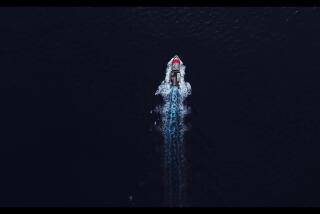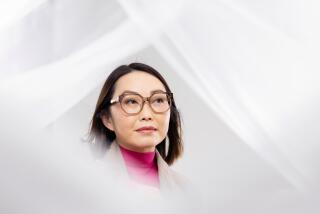Katherine Cheung, 98; Immigrant Was Nation’s First Licensed Asian American Woman Pilot
Katherine Cheung, a Chinese immigrant who defied tradition in the 1930s to become the nation’s first licensed female Asian American aviator, died Tuesday of natural causes at her home in Thousand Oaks. She was 98.
Cheung was born in Canton, China, in 1904 and immigrated to America in 1921 when she was 17. Intent on a musical career, she enrolled at the Los Angeles Conservatory of Music, where she earned a degree in piano; she continued her training at Cal Poly Pomona and USC.
Her plans took a sharp turn skyward the day her father, a produce buyer, took her to Dycer airfield, at 136th Street and Western Avenue, to teach her how to drive a car. Seeing the planes take off and land planted a seed and began her lifelong love affair with flight.
After three years at USC, she dropped out and married her father’s business partner, George Young, who did not object when she decided she wanted to keep her family name. He stood behind her when, a few years later, she put on an aviator’s helmet and declared that her true ambitions flew as high as the horizon.
In 1932, a cousin who was a pilot offered to take her aloft. The experience was so exhilarating that she impulsively signed up for $5-an-hour lessons with the Chinese Aeronautical Assn.
After 12 1/2 hours in the sky, she flew solo for the first time. She earned her license soon afterward, in 1932, becoming the first Chinese American woman to legally pilot a plane. At the time, only about 200, or 1%, of licensed American pilots were women.
Decades later, her name would be enshrined alongside other remarkable pioneers in the Smithsonian’s National Air and Space Museum as the nation’s first female Asian aviator. The Beijing Air Force Aviation Museum calls her “China’s Amelia Earhart” and displays items documenting her many aerial feats.
*
Was Stunt Flier
Cheung didn’t want to just fly a plane: She had a daredevil inside her. She learned stunts, including spiral diving, inverted flying and slow and snap rolls. Soon after earning her license, she was thrilling audiences with her aerobatics at county fairs up and down the California coast.
In 1935 Cheung joined Earhart’s four-year-old international Ninety Nines club for women pilots. Through Earhart, she met such trailblazers as Charles Lindbergh, Roscoe Turner and Pancho Barnes. In 1936 she became a member of the American Aviation Assn.
Her fellow Chinese Americans were so proud of her that, in 1936, they raised $2,000 to buy her a 125-horsepower Fleet biplane. Although her plane was not built to fly higher than 10,000 feet, that year she entered it in a seven-day race from Los Angeles to Cleveland. She barely made it over the Rockies and came in next to last, but she was not the least embarrassed.
Another time, she pitted her little Fleet against more powerful planes flown by dozens of amazing women, including Earhart, in a Glendale-to-San Diego race. Cheung came in fourth. A few years later, when Earhart disappeared while flying over the Pacific, Cheung was grief-stricken.
Though she may have been disappointed that she never set speed and endurance records, Cheung was never discouraged. She was proud to be a pilot, and shared her enthusiasm during frequent appearances in cities with large Chinese populations.
“I don’t see any reason why a Chinese woman can’t be as good a pilot as anyone else,” she told audiences. “We drive automobiles. Why not fly planes?”
*
Plan to Help China
In 1937, when Japan invaded China, she yearned to help her homeland. She wanted to open a flight school in China, which had little air power. Traveling to Chinese American communities across the country, she raised more than $7,000 to buy a Ryan ST-A plane, which she planned to fly to China and use to train volunteer pilots.
But a tragic accident thwarted her plans.
She was accepting the plane from a group of her benefactors at Dycer field when her pilot-cousin -- the one who had introduced her to flying -- suddenly appeared. As a prank, he jumped into the plane and took off. Moments later, as Cheung and the others watched in horror, the plane crashed. Her cousin died.
After the accident, Cheung’s father, on his deathbed, made her promise never to fly again. She agreed, but after her father died, she hopped back in the cockpit.
Earhart’s disappearance, her cousin’s death and the promise she had made to her father weighed heavily on her, however. In 1942, when she was 38, she hung up her wings for good.
A longtime resident of Chinatown until moving to Thousand Oaks more than a decade ago, Cheung is survived by two daughters, Doris Wong of Thousand Oaks and Dorothy Leschenko of Los Angeles; two grandchildren; and four great-grandchildren.
A memorial service will be held at 12:30 p.m. Saturday at Forest Lawn Hollywood Hills, 6300 Forest Lawn Drive, Burbank. Memorial donations may be sent to Senior Concerns, 401 Hodencamp Road, Thousand Oaks, CA 91360, or to Friends of the Chinese American Museum, 125 Paseo de la Plaza, Suite 400, Los Angeles, CA 90012.
More to Read
Sign up for Essential California
The most important California stories and recommendations in your inbox every morning.
You may occasionally receive promotional content from the Los Angeles Times.










